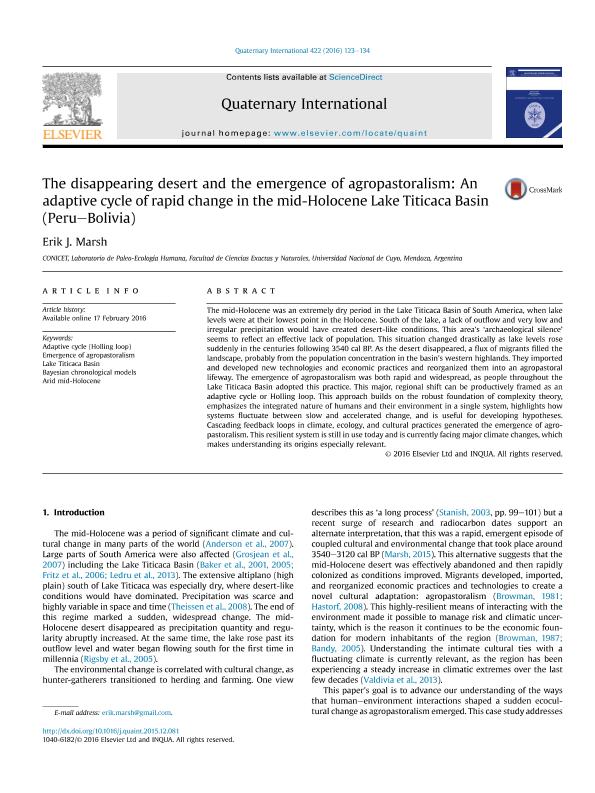Artículo
The disappearing desert and the emergence of agropastoralism: An adaptive cycle of rapid change in the mid-Holocene Lake Titicaca Basin (Peru–Bolivia)
Fecha de publicación:
11/2016
Editorial:
Pergamon-Elsevier Science Ltd
Revista:
Quaternary International
ISSN:
1040-6182
Idioma:
Inglés
Tipo de recurso:
Artículo publicado
Clasificación temática:
Resumen
The mid-Holocene was an extremely dry period in the Lake Titicaca Basin of South America, when lake levels were at their lowest point in the Holocene. South of the lake, a lack of outflow and very low and irregular precipitation would have created desert-like conditions. This area's ‘archaeological silence’ seems to reflect an effective lack of population. This situation changed drastically as lake levels rose suddenly in the centuries following 3540 cal BP. As the desert disappeared, a flux of migrants filled the landscape, probably from the population concentration in the basin's western highlands. They imported and developed new technologies and economic practices and reorganized them into an agropastoral lifeway. The emergence of agropastoralism was both rapid and widespread, as people throughout the Lake Titicaca Basin adopted this practice. This major, regional shift can be productively framed as an adaptive cycle or Holling loop. This approach builds on the robust foundation of complexity theory, emphasizes the integrated nature of humans and their environment in a single system, highlights how systems fluctuate between slow and accelerated change, and is useful for developing hypotheses. Cascading feedback loops in climate, ecology, and cultural practices generated the emergence of agropastoralism. This resilient system is still in use today and is currently facing major climate changes, which makes understanding its origins especially relevant.
Archivos asociados
Licencia
Identificadores
Colecciones
Articulos(CCT - MENDOZA)
Articulos de CTRO.CIENTIFICO TECNOL.CONICET - MENDOZA
Articulos de CTRO.CIENTIFICO TECNOL.CONICET - MENDOZA
Citación
Marsh, Erik Johnson; The disappearing desert and the emergence of agropastoralism: An adaptive cycle of rapid change in the mid-Holocene Lake Titicaca Basin (Peru–Bolivia); Pergamon-Elsevier Science Ltd; Quaternary International; 422; 11-2016; 123-134
Compartir
Altmétricas




